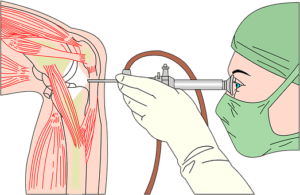I have seen several patients this year who have required knee arthroscopies, largely due to meniscal tears. So what is a meniscus and what is an arthroscopy?
 A meniscus is a piece of tissue (fibrocartilage) which sits between the bones of the knee joints and helps to disperse the friction between the thigh bone (femur) and the lower leg. There are two menisci and they are c shaped.
A meniscus is a piece of tissue (fibrocartilage) which sits between the bones of the knee joints and helps to disperse the friction between the thigh bone (femur) and the lower leg. There are two menisci and they are c shaped.
It is possible to tear the meniscus usually with a twisting injury but even over time with wear and tear it is possible to develop degeneration in the meniscus leading to a tear.
Surgery may be indicated for a meniscal tear, and this is largely dependent on how much pain you are in, and how much the tear is affecting your function.
An Arthroscopy is a type of surgery which is minimally invasive and occurs via a small incision, more commonly known as keyhole surgery. A small device that has a camera attached to it is inserted into the joint which helps the surgeon to examine the extent of damage and guide them during the surgery. In the case of a meniscal tear, the surgeon can get a better idea of the severity of the tear and then either repair or remove part of the meniscus.
As an arthroscopy is minimally invasive, it is considered day surgery which means that you can have your surgery in the morning and be home that afternoon.
Knee arthroscopies can definitely be a worthwhile operation for patients with meniscal tears, especially when conservative management hasn’t helped. Many of the patients we see can return to full exercise capacity without pain within about 3 months.
As always, both the indication for surgery and the recovery from it depends on the individual.
If you are suffering from knee pain and dysfunction, don’t hesitate to contact your Bend + Mend Physiotherapist today.





